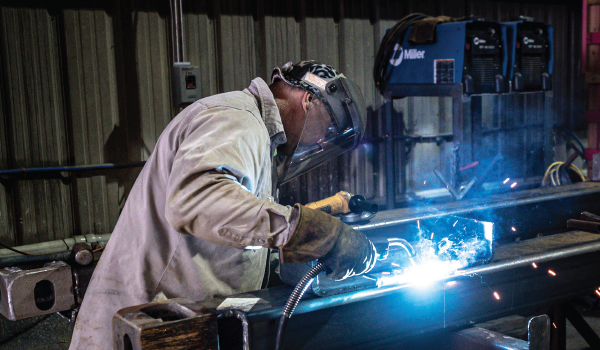Not all blast-resistant buildings are created Equally
When it comes to blast-resistant buildings, it may seem like it makes sense to lump them all into the same category when considering their strength. However, there are differences in their design and build that can make a difference.
RedGuard was one of the first companies to design blast-resistant steel modular buildings in the wake of the 2005 Texas City refinery blast event that took 15 lives and injured 180 others. That event is often referenced as a catalyst for the creation of many of the steel blast-resistant structures in use on oil and gas refineries today.
This article will look at the kinds of blast-resistant buildings available and the differences among one specific category: steel blast-resistant buildings. Of course, in the spirit of full disclosure, it’s important to acknowledge that we design and manufacture steel blast-resistant buildings. We offer this comparison piece to show you why we believe that RedGuard’s steel blast resistant buildings are the kind of safe place you’d want to be in if you found yourself in a blast event.
Are All Blast Resistant Buildings Safe?
Sure, all blast-resistant buildings will offer some blast protection and have appropriate uses, depending on the circumstance and on their blast rating. Yes, all blast-resistant buildings provide some degree of safety, depending on where they are placed.
Some designs provide more protection and are more appropriate to be located near processing units in high hazards. Other buildings are not as rugged and belong in areas of lower hazards.
What Are the Types of Blast-Resistant Structures?
When doing research to choose a safe space for your oil and gas refinery, you’ll find a few different choices to make. These are some of the observations we’ve made through our years in the industry, through third-party engineers that we work with and through extensive testing.
Brick and Mortar Structures
There will always be a place for conventionally designed (brick and mortar) structures, and in hazardous areas, this is also true. When it comes to blast resistance, you can have a building made to your exact blast specifications and also have them outfitted with all the amenities you need and want.
However, it takes time to construct a large complex building and having it made blast-resistant is possible, with the trade-off being time and money, compared to modular options. (A conventional building that isn’t blast-resistant can also be retrofitted for blast resistance, but again, the big trade-off is cost.)
A newer entry into this category is that of the blast resistant precast concrete building. They take less time to build than a traditional brick and mortar blast resistant building, but the price-point of these buildings can be much higher than steel or even brick and mortar buildings.
Blast-Resistant Tents
Another structure worth mentioning is that of the blast-resistant tent. Perhaps you’ve seen these used for large mess halls or gathering places. They are fabric-based structures, reinforced with loose steel support beams, or sometimes with air columns.
While a blast tent will provide some temporary protection, the fabric in their design has not been practically proven for concerns like projectiles. They have large deflections during a blast event, meaning internal items like tables, desks, and other internal elements must be several feet away from the wall. And, due to their structure and the way they must be arranged, the actual usable safe space is much smaller than the footprint of the tent itself.
Steel Blast-Resistant Buildings
Steel blast resistant buildings are perhaps the most common and for good reasons. They are readily available in both temporary and permanent utilizations. They can be leased and added during turnarounds to house temporary workers, and then they can be removed later, when they are no longer necessary. They can also be purchased as permanent structures, and anchored. They are often completely customized for large capital projects.
Among steel blast resistant buildings, there are differentiations among companies as to the designs. It’s essential to ask the companies that you research what the most important parts of their design are and how those elements protect in the event of a blast. We’ll spend some time here looking at the similarities and differences among steel blast-resistant buildings.
How Are Steel Blast-Resistant Buildings Similar?
1. Steel Blast-Resistant Buildings Often Have a Similar Look
People often make the comparison that steel blast resistant buildings are like containers, or Conex boxes. To a certain extent, that is true. But they are NOT containers.
The idea for some of these buildings originated from the steel containers used for tool storage that survived that first notable blast event in Texas City. So a great many of them look like metal shipping boxes.
However, it is important to note that even steel BRBs can be outfitted with aesthetic design elements to match other buildings. Don’t be surprised to find them with brick walls or roofs fabricated to match the aesthetic of other facilities nearby.
One of the reasons they all look the same is their mobile nature. As a cost-saving measure, blast-resistant buildings are made to be carried and transported using the same forklifts, cranes, semi-trucks, and even trains that carry Conex or ISO-boxes. Again, steel blast resistant buildings aren’t containers, but using some ISO specs (like corner blocks) ensures the ability to transport and move blast-resistant buildings, as needed.
2. All Steel Blast-Resistant Buildings Are Blast-Rated
Another similarity is that they are all blast rated to some degree, as mentioned earlier. So, while some are still shaped like containers, it’s important to remember that quite a bit of engineering went into the underlying designs to make steel blast resistant buildings safe.
3. Steel Buildings Flex During a Blast
When a blast wave impacts the surface of a steel blast-resistant building, the steel walls are known to move a minimal amount, sometimes referred to as “flex.” This minimal movement absorbs the energy of the blast wave and protects the building’s occupants. Other building types, particularly precast concrete, are rigid and don’t flex like steel. They instead rely only on the strength of the building material. This flex in a steel building can be thought of as a “fail-safe” that is engineered into the design.
The rigidity of other designs do not absorb or dissipate the blast wave, and will drive all the energy to the building’s connection points, with no fail-safe.
What Are the Differences in Steel Blast-Resistant Buildings?
While we’ve discussed the similarities, the differences are also of considerable importance. There may even be a few things that might not be immediately apparent--the difference in the design elements that can mean the difference between life and death.
1. Blast-Resistant Frame Structure
You’ll find companies that build their structures with a simple steel frame made up of heavy beams and then rely on thick steel around the walls and ceilings to take most of the blast load.
In some designs, the internal beams may be several feet apart, some as much as ten feet apart. In these designs, if one of the major structural members fails, the next closest member could be several feet away. This allows for large deformation in the corrugated panels and also makes them more susceptible to higher response levels or collapse
More robust designs will utilize more closely spaced beams, similar to the rib cage in a human body that protects its vital organs. This close spacing of steel beams is often referred to as redundancy. Buildings with redundancy in their frame design have beams spaced closely to carry the majority of the blast in the event of an explosion. In this design, if one beam fails, there’s another nearby to help pick up the blast load. (Another fail-safe!)
2. Steel Walls and Ceilings
All steel buildings will utilize steel walls and ceilings, but there’s some difference in the type. You’ll find some that use thick, flat steel sheeting, and some that have an S-curve, or corrugation. Corrugation in a steel building design adds strength to the design. (But should never be its only protection.)
Think of corrugated steel as similar to a standard cardboard box design. In between the sides of any standard cardboard box, you’ll find another piece of paperboard that is bent into that familiar S-curve design. The whole thing makes the walls of the cardboard box stronger, more stable, and prevents it from bending into itself. It’s a similar notion that led to the use of corrugated steel in blast-resistant buildings.
The Perfect Combination: Which Is Best?
When it comes to blast-resistant building design, a design that combines closely spaced beams, and corrugated steel walls is the clear winner.
With so many different kinds of blast resistant buildings to consider, it’s always in your interest to review the recommendations that are being made and consider all of your options. In the end, you must make the final informed decision.
At RedGuard, we have always relied on third-party engineering in our many years of research and testing our blast resistant designs. Our designs include all of the important elements mentioned, such as redundant steel beams, and corrugated steel that will flex a minimal amount to absorb much of the blast wave.
If your next step is to take a look at some great blast resistant floor plans, or to start a conversation with a subject matter expert, RedGuard has you covered.
Carreen Gibbons
Carreen Gibbons is the Communications Specialist at RedGuard. With a natural curiosity toward technical subjects and a love of learning new things, she writes content for the SiteBox Storage and RedGuard websites and spends her days learning new things about the industries that the companies serve.




